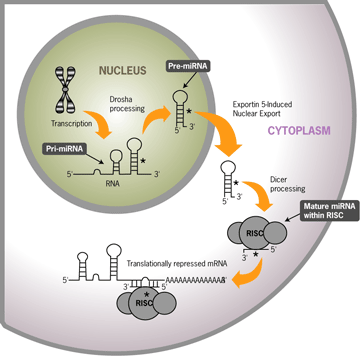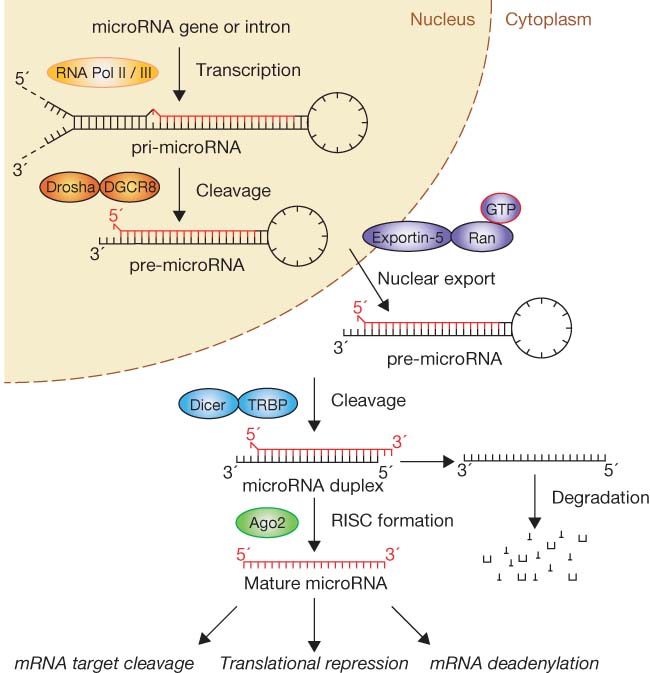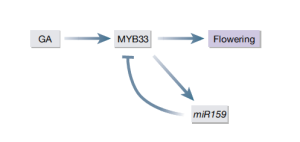Introduction
Like a cookbook recipe, DNA (Deoxyribonucleic acid) provides the essential instructions to make proteins. Since DNA never leaves the nucleolus of the cell, the information from DNA gets copied into mRNA (messenger Ribonucleic acid) molecules by a process called transcription. In eukaryotes, the mRNA molecule leaves the nucleus and goes to an organelle known as the ribosome. Here, the mRNA is translated into polypeptides (polymer of amino acids). However, if the polypeptides are arranged abnormally, drugs are commonly used to block the production of these polypeptides in order to prevent diseases. In 1998, scientists discovered a new process of silencing of specific gene expression triggered by double-stranded RNA (dsRNA), which is much more effective than the blocking of the production of proteins. In 2006, this exciting discovery earned scientists Andrew Fire and Craig Mello a Nobel Prize in Physiology or Medicine. RNA silencing processes are present in almost all eukaryotes. Depending on the organism and the source of the dsRNA trigger, this process controls transcriptional and/or post-transcription gene silencing.
Common Terms for RNA silencing
Over the years, many phenomenon have been observed, but not necessarily understood. As time has passed and research methods have become more technologically advanced, different phenomenon that were observed and named different things can now be grouped together based off of what is occurring during the phenomenon. This is exactly what has happened with RNA silencing, therefore, there are many terms that are used to refer to the main process of RNA silencing. These terms can be considered sub-groups of RNA silencing:
- Cosuppression
- RNA Interference/Post-Transcriptional Gene Silencing
- Quelling
In order to understand the main process of RNA silencing and the specific processes of the sub-groups of RNA silencing, it is important to know different components and features of the processes. The following is a list of terms that may be futile to your understanding of RNA silencing:
- miRNA (microRNA): are non coding RNA molecules that are about 22 nucleotides long and are present in both animals and plants. miRNA regulate translation by cleaving off the unwanted portion of the mRNA molecule. This increases the specificity of the polypeptide the miRNA codes for. The presence of hundreds of different miRNA molecules in a single cell makes it clear that majority of protein coding genes are regulated by these molecules. The following is an illustration of the miRNA process.
- siRNA (small interfering RNA): is a double strand short sequence (twenty or fewer nucleotide bases) of RNA. These molecules bind to a specific portion of mRNA and facilitate the degrading of mRNA. This method is widely used by eukaryotic cells to prevent the production of unwanted polypeptides at a post-transcriptional stage.
- dsRNA (double-stranded RNA): RNA with two complementary strands. dsRNA makes up the genetic material of many viruses
- ssRNA (single-stranded RNA): The form in which RNA molecules are normally found.
- RISC (RNA-Induced Silencing Complex): A complex made up of a siRNA or miRNA, a dicer, and many proteins. More detail will be given later on.
RNA Silencing Process
RNA silencing is a complicated process that involves many different enzymes and molecules. RNA silencing is carried out in a number of ways for different reasons, but ultimately the process serves the same function: to prevent mutation in an organism. One such way is simply to maintain the regulation of gene expression, which occurs constantly throughout the translational process through the use of miRNA. Another way is through the use of dsRNA, which is used to create siRNA. In these two cases, RNA silencing is being utilized to prevent translation and is referred to as post-transcriptional RNA silencing. In another case, however, RNA silencing can be utilized to prevent mRNA from even forming, which is pre-transcriptional RNA silencing and it called transcriptional RNA silencing. The latter of these two methods is not well understood in the scientific community, but some information has been found on what may be occurring during this process.
One method of RNA silencing is carried out through the use or micro RNA, which is considered a regulatory RNA. miRNA can carry out the RNA silencing process in multiple ways, but its main target is the same: mRNA. miRNA is created in the nucleus of a cell, but before becoming miRNA it is primary miRNA or pri-miRNA. Pri-miRNA must undergo post-transcriptional modification before becoming miRNA and each pri-miRNA may contain the precursor for up to six miRNA. This allows amplification of the RNA silencing process if needed. Once miRNA is mature, it can become part of a RNA-Induced Silencing Complex (RISC). The RISC is composed of miRNA, a Dicer, and many different associated proteins. Primarily, members of the argonaute protein family are critical to the RISC function, because they bind to the miRNA and orient it for interaction with the target mRNA. Also, it is important to note that a RISC may also be referred to as miRISC when it has miRNA as a component (this will make more sense later on when the other method of RNA silencing is described). The following is an illustration of this process so far.
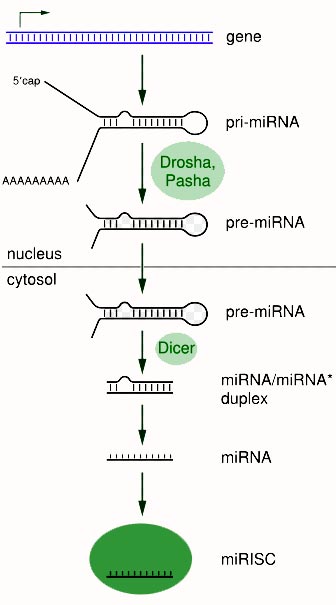
Once miRISC is formed, the silencing process may take place through a number of ways. Typically miRISC can target many different mRNA molecules due to having an incomplete base pairing, which allows it to target multiple mRNA codons. Therefore, one miRISC may regulate the expression of many different genes. The miRISC can do this by locating its target mRNA and then base pairing with it. After this occurs, a number of things may take place. One event that may occur is simply that the miRISC will remain on the mRNA and block translation from occurring by blocking the pathway of tRNA so that it can not read the genetic code in order to create a polypeptide. Another event that may occur is the cleavage of the mRNA into two mRNA sections. One section may still be translated while the other is broken down and recycled by the cell. This creates specificity and control of the polypeptides being synthesized. The decay of the mRNA is sped up through the deadenylation of it by the miRNA, which is when an anion is dissociated from a nucleotide in the RNA. The following is an illustration summarizing the above information.
Another post-transcriptional RNA silencing process involves dsRNA. dsRNA can either be synthesized in an organism or it can be introduced into an organism (such as a virus) in order for the RNA silencing process to occur. No matter where the dsRNA originated, the same RNA silencing process takes place. Endogenous dsRNA, which is dsRNA that originated in the organism or cell, initiates the RNA silencing process by first activating a ribonuclease protein Dicer. The Dicer binds to the dsRNA and then cleaves it into two double-stranded fragments with twenty to twenty-five base pairs and a two nucleotide overhang at the three prime (3′) end. These fragments are called single interfering RNA or siRNA duplexes, which are then broken down into single stranded siRNA after becoming part of the RISC complex. Exogenous dsRNA (dsRNA that originated outside of the cell or organism, like a virus) initiates the RNA silencing process by first being detected by an effector protein. The protein stimulates Dicer activity, the protein binds to the dsRNA, and then cleaves it into two fragments. These fragments are also considered siRNA duplexes and are transformed into single stranded siRNA like in the endogenous dsRNA process. From this point forward, both processes occur in the same manner.
Once single stranded siRNA is formed, it is part of the RISC complex, which has many of the same components as miRISC. Those components include a siRNA (in place of miRNA), a Dicer, and multiple proteins (again, primarily proteins from the argonaute protein family). Once the complex is formed, it then targets its specific mRNA depending on the base pairing present. One of the main differences between the siRNA RISC complex and the miRISC complex, is that the siRNA RISC complex does not target a variety of mRNA, but instead has the base pairing code for only one mRNA while one miRISC can target a variety of mRNA. Once the RISC complex finds its target mRNA, it binds to it, and then cleaves it into two fragments. These two fragments are then recycled by the cell, and the RNA silencing process has been completed. The following is an illustration of the dsRNA silencing process.
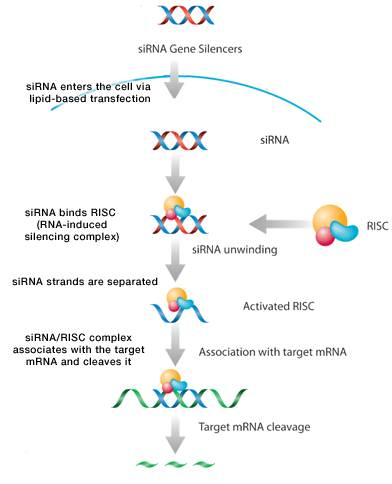 Transcriptional RNA silencing is another RNA silencing process, but it is not very well understood. What is understood about it is that it involves a complex called the RITS complex, which functions to down-regulate genes pre-transcriptionally through the modification of histones and the induction of heterochromatin formation. Modifying the histones serves to regulate the transcription of genes into pre-mRNA, because histones are a protein component of chromatin, which is what DNA structure depends upon. If the DNA structure changes, then how it can be transcribed or what part of it (which genes) can be transcribed also changes. Heterochromatin also influences the transcription of genes, because it is a tightly packed form of DNA, and when DNA is too tightly packed it cannot be transcribed. Therefore, gene regulation is again induced. The following is a chart that shows how similar transcriptional RNA silencing and post-transcriptional RNA silencing are relative to the beginning of their processes, but also how their differing complexes that are formed carry out different functions.
Transcriptional RNA silencing is another RNA silencing process, but it is not very well understood. What is understood about it is that it involves a complex called the RITS complex, which functions to down-regulate genes pre-transcriptionally through the modification of histones and the induction of heterochromatin formation. Modifying the histones serves to regulate the transcription of genes into pre-mRNA, because histones are a protein component of chromatin, which is what DNA structure depends upon. If the DNA structure changes, then how it can be transcribed or what part of it (which genes) can be transcribed also changes. Heterochromatin also influences the transcription of genes, because it is a tightly packed form of DNA, and when DNA is too tightly packed it cannot be transcribed. Therefore, gene regulation is again induced. The following is a chart that shows how similar transcriptional RNA silencing and post-transcriptional RNA silencing are relative to the beginning of their processes, but also how their differing complexes that are formed carry out different functions.
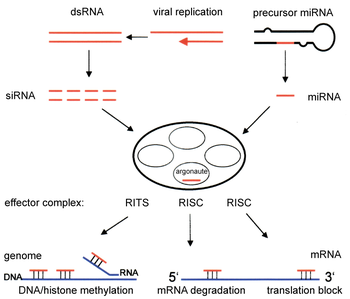 Overall, the RNA silencing process may be carried out in different ways, but every way serves the same purpose: to control gene expression and prevent and protect from mutation in an organism.
Overall, the RNA silencing process may be carried out in different ways, but every way serves the same purpose: to control gene expression and prevent and protect from mutation in an organism.
The following video is a great example of the RNA silencing process.
The following is a great animation of the RNA silencing process when the RISC complex acts to block or prevent transcription by bonding to mRNA or when it cleaves mRNA, respectively. Although it can be a little confusing to understand, since none of the molecules are labeled, after reading this section and the previous sections, it should be quite simple to identify which molecules are which based on the function that they are carrying out.
Sources:
“MicroRNA (miRNA) Resource.” Ambion, Inc. – The RNA Company. Web. 10 Nov. 2010.
<http://www.ambion.com/techlib/resources/miRNA/index.html>.
Major Implications of RNA Silencing…Why is it important?
First, found in tobacco plants as a viral defense role against the ringspot virus, which presents the first role of RNA silencing. As seen in the infected tobacco plant, the ringspot virus on the lower leaves activates the viral RNA silencing to inhibit the virus from spreading to the upper leaves. Another role of RNA silencing in plants includes the protection of the genome from the damage that could be done by DNA methylation of certain nucleotide sequences, which is guided by transgene and viral RNAs. Although the viral RNA has its own defense against the RNA silencing mechanisms, which are primarily enforced through suppressor proteins that are part of the genome of the particular virus, and have enough of a structure difference, through evolution, that they do not have a common sequence associated with them. The secondary mechanism, by which they defend themselves, is thought to be through a compartmentalized structure that allows for the RNA to be hidden from the silencing mechanisms. Not only can the cells have a silencing role against the virus, but the virus itself can induce the silencing and suppress the cell itself, which can be the cause of the symptoms that the plant exhibits. The feedback mechanism is also used in plants to regulate the amount of mRNAs being made depending on the amount of silencing miRNAs present in the cell. One specific example of this is gibberellic acid (GA), which, when stimulated, increases MYB33 that initiates flowering, and also produces in increases in miR159. miR159 then acts on the increase in MYB33 to decrease the production of GA, as seen in Figure 1.
Figure 1 – Diagram of feedback RNA silencing plants
(RNA silencing in plants, David Baulcombe NATURE | VOL 431 | 16 SEPTEMBER 2004 | http://www.nature.com/nature)
The viral defense role is not confined to plants, but is found in a variety of eukaryotic organisms. Being the most common role of RNA silencing in animals, the overarching goal is to protect the genetic code from damage and mutation. In an effort to distinguish between the “good” mRNAs and the “bad” mRNAs, all of the “good” mRNAs have a similar structure that is characteristic to that person. The “bad” mRNAs are targeted by siRNAs, cut portions (by the Dicer enzyme) of dsRNA, through the base pair interactions, which allow other enzymes to come in and cut the mRNA into pieces. This provides amplification of the response to a particular set of “bad” mRNAs, which is again amplified by the catalytic mechanism that allows each of the siRNAs to be used multiple times. When there are no more mRNAs to be base paired to, the siRNAs are no longer made since they are not stable when by themselves for very long. The role of RNA silencing in animals still has a lot that needs to be worked on.
(RNA Silencing: The Genome’s Immune System, Ronald H. A. Plasterk, http://www.sciencemag.org SCIENCE VOL 296 17 MAY 2002)
The following video shows the processes in pictoral format in even more detail:
RNA Silencing in the Future
In the past few years the use of RNAi-based therapeutic has been highly adopted in treating different diseases. This type of treatment targets and destroys RNA molecules responsible for the production of polypeptides that facilitate disease progression. RNAi treatment is being tested to cure the following diseases that are very common in our society.
Cancer: cancer cells have two characteristics that distinguish them from normal body cells. One of the characteristics of cancer cell is that they have a deregulated cell cycle resulting in Neoplasia (uncontrolled cell division). And the other characteristics of these cells is that they lack proper structures and function differentiation (Anaplasia). Therefore, RNAi is used to prevent the translation of mRNA sequence into a polypeptide which causes ubnobalities in cell division and Anaplasia. However altering cancer cells without affecting normal cells is a very difficult task. Therefore, The RNAi is designed to affect genes that are strictly involved in the production of cancer cells.
HIV: HIV is the first infectious diseases to be targeted by RNAi. This method of utilizing RNAi was used to successfully downgrade cofactors and coreceptors of HIV, preventing the replication of HIV virus in T-cells and hematopoietic-stem-cell-derived macrophages. However, this method affects non-infected cells causing the same effects as the current anti-retroviral drugs. Therefore, shRNA is mixed with antiviral genes to make a more effective combination. Researchers are also trying to come up with a more effective combination of iRNA with a non-iRNA antiviral molecule in the near future. The delivery of iRNA into HIV-infected cell presents another hurdle for scientist to overcome. And since the siRNA does not stay in the cell for long periods, they would also have to deliver siRNAs for years to effectively treat the desease. However systemic delivery is not yet practicable, so T-cells are isolated from the patient; these cells are then transduced, expanded ex vivo, and infused back into the patient. Since the use of RNAi is promising and more effective, this technology is expected be used in human clinical trial for HIV treatment in the next year or two.
Hepatitis Virus: is an infectious disease caused by DNA virus which infects liver cells. This virus uses an enzyme called reverse transcriptase to make DNA strands that will get incorporated into the host genome. This disease has also caused epidemics in different parts of the world. Eventhough vaccines are available for Hepatitis A and B, there are no treatments for Hepatitis C and for people that are infected. Therefore, RNAi is used to prevent DNA replication of infected cells and virus gene expression.
Cardiovascular diseases: Cardiovascular diseases are responsible for large number of deaths in the United States and other industrialized countries. Usually this results in Atherosclerosis. This is caused when the damage in the artery walls results in a narrow passage for blood. In most cases this results in stroke or heart attack. RNAi can be used to intervene in the process of atherosclerosis development. This process regulates cell adhesion molecules in vascular cells which in return will result in a higher amount of macrophages in the site of damage. The following video gives a good description about Atherosclerosis.
-
Recent
-
Links
-
Archives
- November 2010 (5)
-
Categories
-
RSS
Entries RSS
Comments RSS
